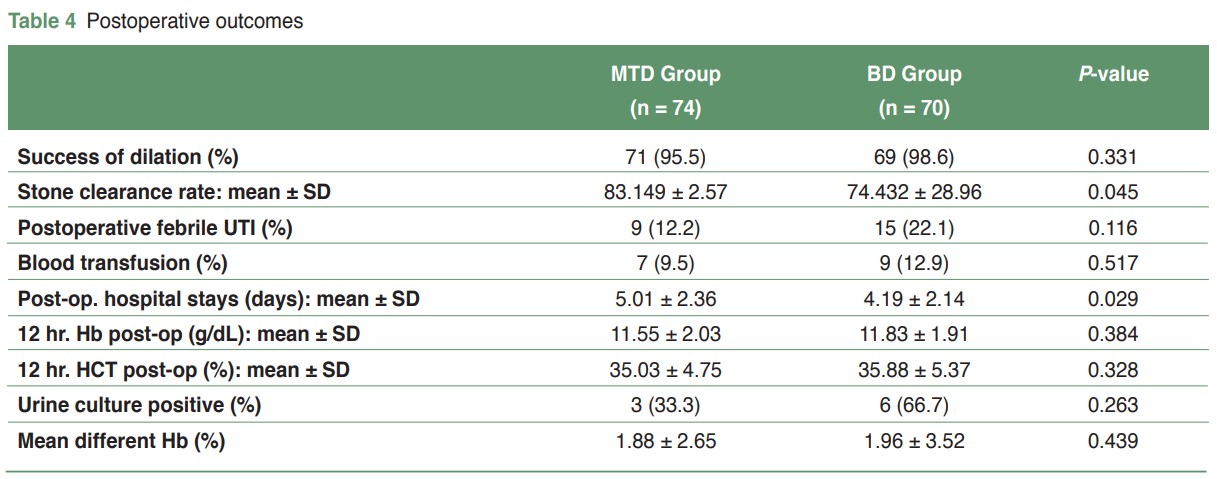Comparative Analysis of Balloon Tract Dilator and Metal Telescopic Dilators for Percutaneous Nephrolithotomy in Thai Patient Population
Keywords:
Balloon dilator, Alken metal dilators, Percutaneous nephrolithotomyAbstract
Background: Balloon dilators for percutaneous nephrolithotomy (PCNL) have been adopted in various countries worldwide. However, its utilization remains limited in Thailand due to the equipment cost and the country's higher morbidity and complexity of renal stones. We performed a comparative study between the outcomes of balloon dilators (BD) and the commonly used metal telescopic dilators (MTDs) in Thai patients who underwent PCNL.
Methods: We conducted a retrospective review of 199 patients who underwent PCNL between Jan 2011 and July 2022. We excluded patients with risk for bleeding and active infection from our study. 144 patients were recruited in our study: 74 patients in the MTD group and 70 patients in the BD group. The success rate and complication of both methods of dilation were compared. Continuous demographic data was compared with an independent t-test. A generalized linear model was applied to assess the multivariable analysis's mean differences and risk differences.
Results: Demographic data of patients in both groups were not significantly different in size of stone, age, and history of kidney surgery. The success rate of dilatation was 95.5% and 98.6% for MTD and BD, respectively (p = 0.331). Renal pelvic injury was 8.1% for MTD and 10% for BD (p = 0.692). Stone clearance rates were 100% and 82.48% for MTD and BD, respectively (p = 0.098). LOS of both groups was not significantly different by multivariate analysis.
Conclusion: Both dilatation methods demonstrated comparable success rates, blood loss, and hospital stays in PCNL for renal stones. In the Thai population with a high prevalence of large renal stones, BD remains an effective option in most situations.
References
Fernström I, Johansson B. Percutaneous pyelolithotomy. A new extraction technique. Scand J Urol Nephrol. 1976;10:257-9. doi:10.1080/21681805.1976.11882084.
EAU Guidelines. Edn. presented at the EAU Annual Congress Milan 2023. ISBN 978-94-92671-19-6.
Lojanapiwat B. Previous open nephrolithotomy: does it affect percutaneous nephrolithotomy techniques and outcome? J Endourol. 2006;20:17-20. doi:10.1089/end.2006.20.17.
Sabler IM, Katafigiotis I, Gofrit ON, et al. Present indications and techniques of percutaneous nephrolithotomy: What the future holds? Asian J Urol. 2018;5:287-294. doi:10.1016/j.ajur.2018.08.004.
Davidoff R, Bellman GC. Influence of technique of percutaneous tract creation on incidence of renal hemorrhage. J Urol. 1997;157:1229-31.
Nouri M, Tligui M, Flahaut A, et al. La dilatation pariéto rénale au ballonnet dans la chirurgie percutanée du rein [Balloon catheter parieto-renal dilatation in percutaneous kidney surgery]. Prog Urol. 2000;10:1131-4.
Yanagawa M, Kawamura J, Onishi T, et al. Incidence of urolithiasis in northeast Thailand. Int J Urol. 1997;4:537-40. doi:10.1111/j.1442-2042.1997.tb00304.x.
Lopes T, Sangam K, Alken P, et al. The Clinical Research Office of the Endourological Society Percutaneous Nephrolithotomy Global Study: tract dilation comparisons in 5537 patients. J Endourol. 2011;25:755-62. doi:10.1089/end.2010.0488.
Wezel F, Mamoulakis C, Rioja J, et al. Two contemporary series of percutaneous tract dilation for percutaneous nephrolithotomy. J Endourol. 2009;23:1655-61. doi:10.1089/end.2009.0213.
Dehong C, Liangren L, Huawei L, et al. A comparison among four tract dilation methods of percutaneous nephrolithotomy: a systematic review and meta-analysis. Urolithiasis. 2013;41:523-30. doi:10.1007/s00240-013-0598-z.
El-Shazly M, Salem S, Allam A, et al. Balloon dilator versus telescopic metal dilators for tract dilatation during percutaneous nephrolithotomy for staghorn stones and calyceal stones. Arab J Urol. 2015;13:80-3. doi:10.1016/j.aju.2014.12.004.
Kumar V, Keeley FX Jr. Percutaneous nephrolithotomy: why do we use rigid dilators? J Endourol. 2008;22:1877-9. doi:10.1089/end.2008.9785.
Kukreja R, Desai M, Patel S, et al. Factors affecting blood loss during percutaneous nephrolithotomy: prospective study. J Endourol. 2004;18:715-22. doi:10.1089/end.2004.18.715.

Downloads
Published
How to Cite
Issue
Section
License
Copyright (c) 2023 The Royal College of Surgeons of Thailand

This work is licensed under a Creative Commons Attribution-NonCommercial-NoDerivatives 4.0 International License.
Articles must be contributed solely to The Thai Journal of Surgery and when published become the property of the Royal College of Surgeons of Thailand. The Royal College of Surgeons of Thailand reserves copyright on all published materials and such materials may not be reproduced in any form without the written permission.


